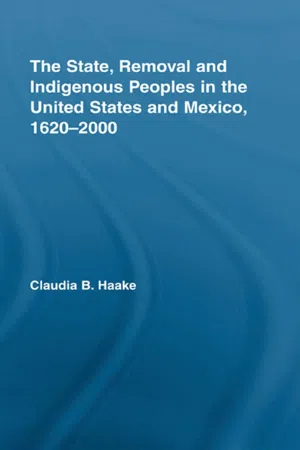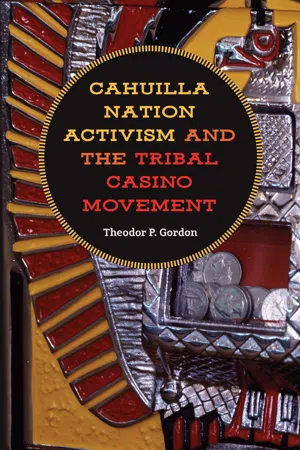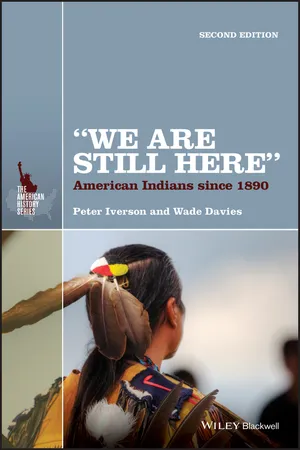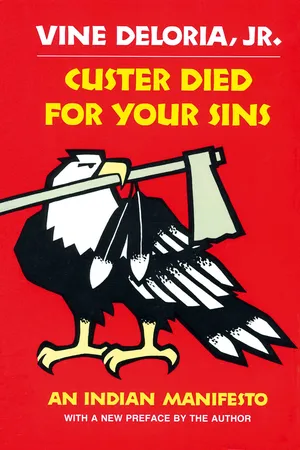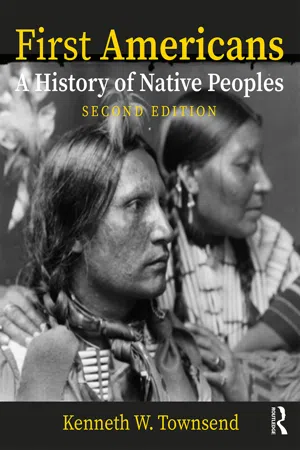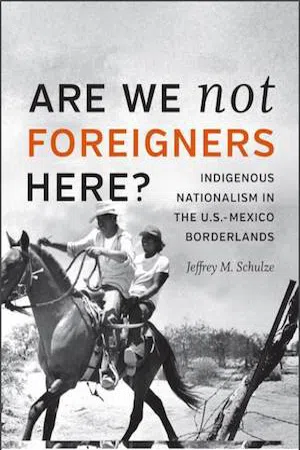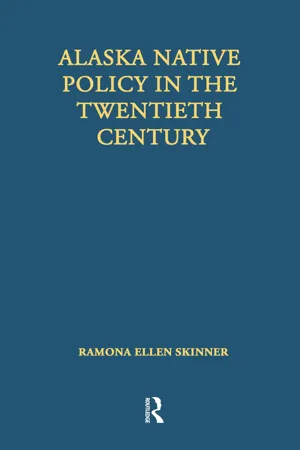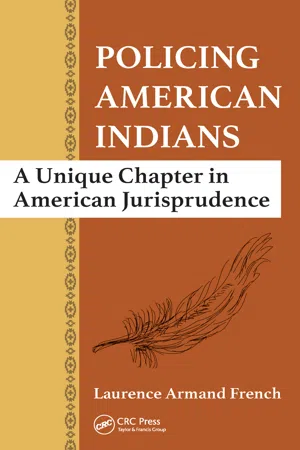History
Indian Termination Policy
The Indian Termination Policy was a US government initiative in the 1950s aimed at ending the special relationship between Native American tribes and the federal government. It sought to assimilate Native Americans into mainstream American society by terminating tribal sovereignty, relocating individuals to urban areas, and selling off reservation lands. The policy was widely criticized for its detrimental impact on Native American communities.
Written by Perlego with AI-assistance
Related key terms
Related key terms
1 of 4
Related key terms
1 of 3
9 Key excerpts on "Indian Termination Policy"
- Claudia Haake(Author)
- 2007(Publication Date)
- Routledge(Publisher)
The effects on the terminated tribes were often disastrous. Land ownership changed fundamentally, the trust relationship was ended, state jurisdiction and state judicial authority were imposed, exemption from state taxing power was terminated, federal programs were discontinued, and—most importantly—tribal sovereignty was ended. 48 The benefits the Indians gained in return were very small, usually limited to a single payment. But, as Peter Iverson has stated, “the threat of federal withdrawal helped galvanize the beginnings of the modern Native American movement toward self-determination” and hence in some respects termination could be considered to have backfired. 49 While the program furthered urban migration that did not automatically bring about assimilation. Donald Fixico has pointed out that “urban Indians chose not to assimilate and white society did not encourage acceptance of Indians.” 50 Pan-Indianism was encouraged through the common experience of racism and other problems in the cities. Between 1953 and 1958, 109 indigenous nations or parts thereof were terminated under this policy. 51 The Termination program was brought to a halt as quickly as it had begun. In 1958 it was announced that no Indian tribe would be terminated without its consent. But it took until 1970 and the government of Richard Nixon to officially repudiate the policy of termination. Some communities like the Klamath and Menominee were later restored after petitioning Congress but others are still trying to accomplish this goal today. Another post-war policy and also yet another attempt to assimilate the Indians into the American mainstream of the 1950s and 60s was relocation. It was based on a public law commonly know as the Relocation Act, which was passed in 1956. Federal funds available for Indian programs were rapidly decreasing, and already poor services suffered even more- Theodor P Gordon(Author)
- 2018(Publication Date)
- University of Nevada Press(Publisher)
4 TERMINATION AND REVITALIZATION P UBLIC POLICIES can sometimes produce unintended results. There might be no greater example of this than the federal policies that sought to force American Indians to assimilate. These unintended results can especially be seen in the middle of the twentieth century, when Congress pursued an agenda that is now known as termination. Coupled with the attempt to assimilate native children by requiring them to attend boarding schools, termination only strengthened the resolve of native nations to retain their sovereignty. Policymakers wrongly assumed that if the federal government ceased its acknowledgment of tribal sovereignty, then it would disappear. Federal policies fomented a resurgence of tribal sovereignty that reaches into the present day, including the tribal gaming movement. This chapter examines the impacts of the termination policies and how the Cahuilla contributed to the larger movement of revitalizing sovereignty. Termination Around the middle of the twentieth century Congress began systematically repealing the Indian Reorganization Act, which had overturned the Dawes Act and encouraged limited forms of native nation self-determination. In August 1953 Congress passed House Concurrent Resolution 108 that asserted the federal government was to act “as rapidly as possible, to make the Indians. . .subject to the same laws and entitled to the same privileges and responsibilities as are applicable to other citizens. . .[and] to end their status as wards” (B132). Later that month Congress passed Public Law 280 (Pub.L. 83-280). (See chapter 5 for further discussion of the significant role Public Law 280 played in Cabazon’s case before the Supreme Court.) Public Law 280 provided six states with criminal jurisdiction on Indian lands within those states, marking the first time since Worcester v. Georgia (1832) that the federal government granted states significant authority on tribal land; it now applies in sixteen states- eBook - ePub
- Paul R. Brass, Paul R. Brass(Authors)
- 2023(Publication Date)
- Routledge(Publisher)
[ 4 ] The resolution was not self-executing and specific legislation was needed to deal with the method of terminating particular tribes. Each tribe presented a different complex of problems, including methods of disposition of tribally owned lands and natural resources. The following year Congress passed six Termination acts afecting a number of tribes, and thereafter continued to enact termination bills until 1962. All told, 13 termination acts were passed, but they affected not more than three percent of all federally recognized Indians, many belonging to scattered small tribal groups and bands. [ 5 ] However, among the terminated tribes and bands were two large groups, the Menominee of Wisconsin, numbering 3,270 and the Klamath of Oregon, numbering 2,133. They were highly visible and their fate under the Termination program ultimately branded it a failure in the eyes of Congress and the American public. The Menominee were brought to the brink of economic and social disaster [ 6 ] and the Klamath lost a valuable renewable resource, their timber holdings, in return for a one-time-only cash pay- ment. [ 7 ] By the late 1960s, the Termination Policy was severely discredited, although it retained and still retains many adherents. The perceived failures of the Termination Policy coincided with the rise of the Civil Rights movement in America. The combination resulted in the revival of the policy favoring tribal autonomy. III. THE CIVIL RIGHTS ERA AND THE GROWTH OF AUTONOMY POLICY: 1960-1970 The Termination Policy of the 1950s had aroused Indian tribes and pan-Indian organizations to speak out widely and to argue for self-determination. The national mood was sympathetic to the plaint of racial minorities and shortly after his inauguration, President John F. Kennedy pledged that self-determination would be a principal goal of his Indian policy - eBook - ePub
"We Are Still Here"
American Indians Since 1890
- Peter Iverson, Wade Davies(Authors)
- 2014(Publication Date)
- Wiley-Blackwell(Publisher)
Reader's Digest, the answer seemed simple. “Set the Indians Free!,” he entitled his article. He urged Congress to “emancipate” the Indians by removing “restrictions” that stood in their way. Free from the roadblocks imposed by federal trusteeship, Native American communities would be liberated to achieve new heights now denied them. America, he argued, should not foster segregation but integration. Others owned lands privately rather than in common. The idea of a reservation had become outmoded. Employing rhetoric and logic eerily comparable to the language and reasoning of Indian policy reformers during the late nineteenth century, Armstrong called for a new era in Indian affairs. The Indians had proved their mettle during the war; they were ready to become full-fledged Americans. However, this effort to terminate federal trust responsibility spelled potential disaster for Indian America.Two interrelated developments marked the period from war's end until the beginning of the 1960s. The first helped encourage the second. The drive toward terminating federal trust responsibility for Indians caused immediate harm and sometimes lasting damage to certain Indian communities. However, the threat of federal withdrawal helped galvanize the beginnings of the modern Native American movement toward self-determination. Indian individuals and groups responded forcefully to reaffirm their rights and to find new means to realize them. Federal policies, then, did have negative consequences, yet Indians during this time also constructed the foundation for a movement in the 1960s that, like the African-American civil rights movement, had its origins in the prior decade.Congress officially launched termination by passing Concurrent Resolution 108 in 1953, but the resolution followed years of discussion and debate. The goals of withdrawing federal services from and federal protection of Indian communities fit well with the more conservative postwar mood in the United States. Republicans were more likely to favor turning Indian affairs over to the states, but momentum for termination developed during the Truman administration. Critics called for “liberation” of the Indians from the shackles of federal paternalism. They perceived reservations as antiquated relics of a bygone age. If reservations could be eliminated, their acreage fully divided into property, and individual Indians freed from the restraint of federal bureaucracy, they professed, Indians would be better able to reach their full potential.Not all Native Americans disagreed with this prescription. Some fully subscribed to the idea of assimilation, while others bitterly resented the kind of control BIA officials still appeared to maintain over tribal councils. With the postwar economic boom centered in urban America, more than a few Indians saw the cities as places where opportunity beckoned. Yet most Native Americans wanted relocation to urban areas to be voluntary rather than required. They recognized that the young could migrate to the city more easily and effectively than could older people. Indians knew that relocation could sever connections to the land and relationships among extended family members. They resented the heavy-handed tactics and simplistic thinking embraced by congressional proponents of “reform.” In the process of resisting an imposed direction, Native persons increasingly began to chart a direction of their own, one that emphasized pride in tribal and Indian identity and a conviction that Indians were entitled to a wide range of rights. - eBook - ePub
- Vine Deloria(Author)
- 2018(Publication Date)
- Scribner(Publisher)
THE DISASTROUS POLICY OF TERMINATIONPEOPLE OFTEN FEEL guilty about their ancestors killing all those Indians years ago. But they shouldn’t feel guilty about the distant past. Just the last two decades have seen a more devious but hardly less successful war waged against Indian communities. In the old days blankets infected with smallpox were given to the tribes in an effort to decimate them. In the past they were systematically hunted down and destroyed. Were an individual citizen to do this it would be classified as cold-blooded murder. When it was done by the U.S. Army it was an “Indian war.” But during the past twenty years federal medical services have been denied various tribes, resulting in tremendous increase in disease.The Congressional policy of termination, advanced in 1954 and pushed vigorously for nearly a decade, was a combination of the old systematic hunt and the deprivation of services. Yet this policy was not conceived as a policy of murder. Rather it was thought that it would provide that elusive “answer” to the Indian problem. And when it proved to be no answer at all, Congress continued its policy, having found a new weapon in the ancient battle for Indian land.The roots of termination extend backward in time to the early years of the Roosevelt administration. The New Deal ushered in a new program for the Indian people. The Meriam Report of 1928 had shown that Indian tribes were in a desperate situation. There had been no progress of any kind on the reservations since they were set up. The people were in the final stages of demise.Pressures for reform coincided with the election of Roosevelt, who appointed John Collier as Commissioner of Indian Affairs. Collier was a well-known anthropologist of liberal persuasion. He quickly pushed the Wheeler-Howard Act through Congress in 1934 and gave the reservations their first taste of self-government in nearly half a century. - eBook - ePub
First Americans: A History of Native Peoples, Combined Volume
A History of Native Peoples, PowerPoints
- Kenneth W. Townsend(Author)
- 2018(Publication Date)
- Routledge(Publisher)
Termination crippled tribes. “To us,” said John Wooden Legs (Cheyenne), “to be Cheyenne means being one tribe—living in our own land—in America, where we are citizens. Our land is everything to us… . It is the only place where Cheyenne remember [the] same things together. I will tell you one of the things we remember on our land. We remember that our grandfathers paid for it—with their lives.”Termination failed to deliver on its promise of freedom; indeed, the government’s view of freedom stood in sharp contrast with that of reservation Indians. Following the advance of white society, freedom lay on the reservation, protected by treaties with the federal government. There, and only there, could Indians live as Indians, clinging to a social structure of their choice, holding to a spiritual awareness they preferred, and preserving an identity they cherished despite the acculturation programs of the Indian Office. Termination in both intent and practice imposed on Native Americans a direction contrary to Indian preferences. “Choice” under termination was non-existent—self-determination was an illusion. Said Felix Cohen, “If a government repudiates its obligations to a white man we speak of ‘governmental bankruptcy.’ … If a government repudiates its obligations to an Indian, this is commonly referred to as ‘emancipating the Indian.’ ”Termination fever waned by the late 1950s. The program actually increased BIA expenses, and bureau employment rose 20 percent. Indian complaints, failed cases such as the Menominee, and the persistent lobbying activities of the NCAI combined led Secretary of the Interior Fred Seaton to announce that termination would no longer proceed without explicit Indian consent, a position President Eisenhower eventually encouraged. The Republican Party Platform for the 1960 presidential race called the “precipitous termination” of federal Indian trusteeship unacceptable and maintained that the party would not terminate “any tribe which has not approved such action.” - eBook - ePub
Are We Not Foreigners Here?
Indigenous Nationalism in the U.S.-Mexico Borderlands
- Jeffrey M. Schulze(Author)
- 2018(Publication Date)
- The University of North Carolina Press(Publisher)
14It would be yet another challenge nascent indigenous nations like the ones discussed herein would face in reclaiming and/or protecting tribal sovereignty. Although policymakers never viewed the IRA as a complete failure, the act was nevertheless allowed to languish during the war years. Congress began the 1950s with yet another legislative about-face in the form of a new policy current ominously referred to as “termination.” Essentially, termination comprised twelve measures aimed at severing trust relationships between the federal government and all tribes located in Florida, New York, Texas, and California, and individual tribes such as the Menominee, Klamath, Flathead, Chippewa, and Potawatomi. The new legislation relegated governmental responsibilities in the areas of social welfare, education, law enforcement, and economic assistance to the individual states, thereby effectively terminating tribal ties with the federal government and abolishing some reservations.15Termination resembled the Dawes Act not only in its ultimate objectives, which included complete cultural and economic mainstreaming and the revocation of tribal sovereignty, but also in its ideological origins. The Dawes Act reflected prevailing national sentiment in the post–Civil War years, as the country united in an attempt to redefine “nationhood” by calling for some semblance of national unity in the face of continued cultural diversity. In this environment, the conspicuous presence of political and cultural “islands” was particularly distressing.16 Similarly, in the post–World War II era, with McCarthyism in full swing, reservations came under attack, with pundits claiming that they represented socialist institutions sanctioned by and situated within the confines of the self-proclaimed “greatest democracy in the world.” The emphasis placed on American Indian tribalism and cultural regeneration and preservation during the Collier era of Indian affairs would find an ideological complement in the Indian rights movement of the 1960s and 1970s. Put simply, termination, much like the Dawes Act, failed to bear fruit, instead only deepening the Indians’ dependence on the federal government while doing little to alienate them from their tribal identities. The second half of the twentieth century witnessed the formation of AIM, or the American Indian Movement, which maintained a presence, in sometimes aggressive fashion, in the national political arena on behalf of Indian peoples across the country. It also witnessed the passage of the 1975 Indian Self-Determination and Education Assistance Act, which represented a further attempt at placing more political power in the hands of the Indians themselves.17 In the 1960s, as in the 1930s, the United States found itself swept up in a spirit of reform that touched many aspects of federal policy, leading many to renew their commitment to the “Indian cause.” From here Indians would experience a surge in cultural pride, a renewed commitment to protecting hunting and fishing rights, an erosion of the authority of the BIA and of non-Indian religious institutions, and the strengthening of tribal governments and courts. “It is the great irony of nineteenth-century Indian policy,” the legal scholar Charles Wilkinson points out, “that the sharply reduced tribal landholdings, which Native peoples bitterly protested, later became cherished homelands and the foundation for the modern sovereignty movement.”18 - eBook - ePub
- Ramona Ellen Skinner(Author)
- 2019(Publication Date)
- Routledge(Publisher)
Like nineteenth-century Indian policy, twentieth-century Indian policy also focused on a solution to the “Indian problem.” This required federal cooperation with Native peoples which resulted in an enormous federal financial and administrative entanglement. Once the policy makers solved the “Indian problem,” the federal government would no longer be in the business of providing support for Indian programs and services or be responsible for administrating Indian trust lands or supervising Indian affairs. In effect, resolving the “Indian problem” entails getting out of the “Indian business,” demanding that Congress terminate the trust relationship.NOTES
1. Francis Jennings, The Invasion of America (New York: W.W. Norton and Company, 1975), 15.2. Ibid., 15, 61; Francis Jennings, The Founders of America: From the Earliest Migrations to the Present (New York: W. W. Norton and Company, 1993), 83.3. For a comprehensive treatment of the Indian Trade and Intercourse Acts, see Francis Paul Prucha, American Indian Policy in the Formative Years: The Indian Trade and Intercourse Acts, 1790–1834 (Cambridge: Harvard University Press, 1962).4. Ibid., 2; Charles F. Wilkinson and Eric R. Biggs, “Evolution of the Termination Policy,” American Indian Law Review 5 (Number 1, 1977): 141.5. S. Lyman Tyler, A History of Indian Policy (Washington, D.C.: Bureau of Indian Affairs, 1973), 45.6. Ibid., 46.7. R. David Edmunds, “National Expansion from the Indian Perspective,” in Indians in American History, Frederick E. Hoxie, ed. (Arlington Heights, Ill.: Harlan Davidson, Inc., 1988), 174.8. Ibid.9. Felix S. Cohen, “Original Indian Title,” in The Legal Conscience-Selected Papers of Felix S. Cohen, Lucy Kramer Cohen, ed. (Hamden, Conn.: Archon Books, 1970), 273.10. Rennard Strickland and Charles F. Wilkinson, eds., Felix S. Cohen’s Handbook of Federal Indian Law (Charlottesville, Va.: Michie Bobbs-Merril, 1982), 473.11. Frank Pommersheim, Braid of Feathers: American Indian Law and Contemporary Tribal Life (Berkeley: University of California Press, 1995), 40-41.12. Johnson v. McIntosh 21 US 543 (1823).13. Ibid.14. Charles F. Wilkinson, American Indians, Time, and the Law: Native Societies in a Modern Constitutional Democracy (New Haven, Conn.: Yale University Press, 1987), 40.15. Robert A. Williams, Jr., The American Indian in Western Legal Thought: The Discourse of Conquest (Oxford: Oxford University Press, 1990), 315.16. Ibid., 317.17. Cherokee Nation v. Georgia - eBook - ePub
Policing American Indians
A Unique Chapter in American Jurisprudence
- Laurence Armand French(Author)
- 2015(Publication Date)
- Routledge(Publisher)
accommodation , with a shared but separate social structure, was never intended as a viable plan. Indian wars continued despite the new peace policy, especially with the Apache of the Southwest and the Plains Indian tribes. These policies did much to increase the level of conflict, making a mockery of President Grant’s so-called peace policy. The policy of demonizing American Indians who wanted to maintain their traditional ways and customs, along with the invasion of religious groups mandated to educate, domesticate, and otherwise civilize the tribes, set forth the era of competing physical genocide by the U.S. military and the onslaught of cultural genocide and Christian ethnocentrism by church groups. Hence, the Indian wars lasted from the 1860s until the Wounded Knee Massacre of December 29, 1890.Treaties were made with the Siouan tribes and their neighbors, the Crow, Arapaho, and Cheyenne, in 1851, 1865, and 1868. The 1851 Fort Laramie Treaty stipulated that the U.S. government had the right to establish roads and military and other posts in the Lakota Sioux, Crow, Cheyenne, and Arapaho tribal lands, while also promising to protect the tribes from further intrusions by outsiders (white settlers). The 1862 Great Sioux Uprising among the Santee (Dakota) Sioux marked the beginning of 28 years of conflict, deceit, and massacres, culminating with the summary execution of Hunkpapa Sioux medicine man Sitting Bull at the Fort Yates Reservation on December 15, 1890, and the massacre of Big Foot and 146 members of his party at Wounded Knee on the Pine Ridge Reservation on December 29, 1890. The terms of the 1868 Fort Laramie Treaty were supposed to provide the Lakota Sioux with a substantial territory consisting of South Dakota, part of North Dakota, and the northwestern portion of Nebraska—hence the Great Sioux Reservation
Index pages curate the most relevant extracts from our library of academic textbooks. They’ve been created using an in-house natural language model (NLM), each adding context and meaning to key research topics.
Explore more topic indexes
Explore more topic indexes
1 of 6
Explore more topic indexes
1 of 4
